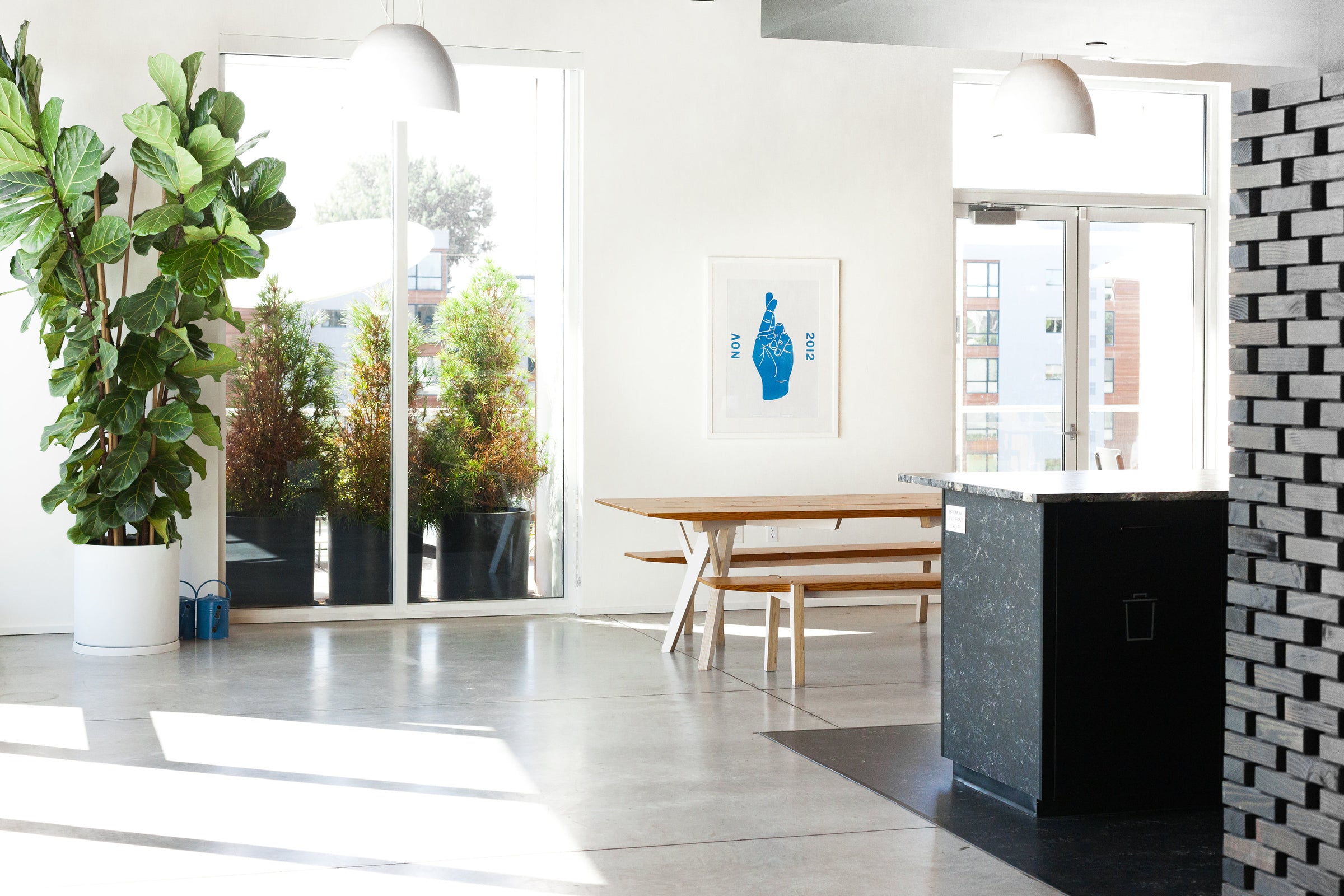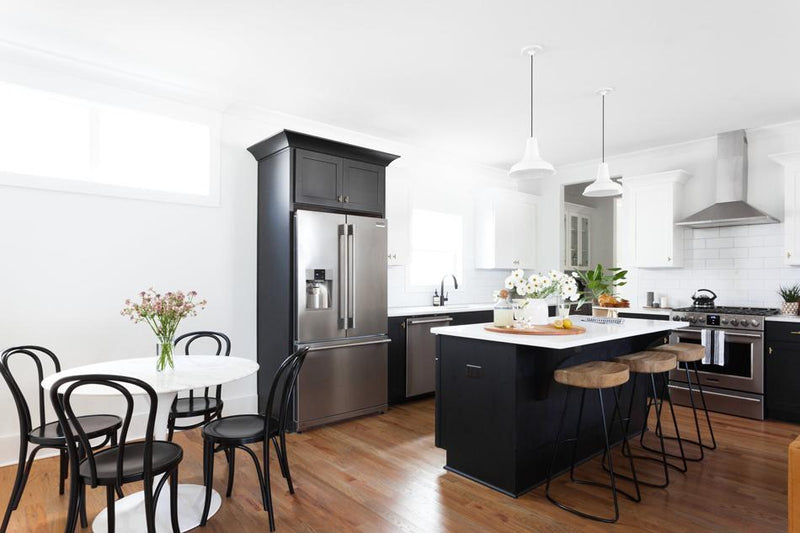Schoolhouse Spaces: Instrument

Innovative and bursting with heart, Portland’s favorite independent digital agency Instrument practices what they preach by crafting inspiring and thoughtful products and experiences for major brands like Google, Facebook, and Nike. Though everything they do is grounded in the tech sphere, their physical surroundings are a crucial element to their online successes. It makes sense that when given complete control over their workspace Instrument would create something truly stunning in providing a home where creativity and collaboration can spark the next big idea.
It was during the Schoolhouse Bus Tour that we first toured the three-story, 30,000 square foot building that houses their expansive roster of talent. With floor-to-ceiling windows, rows of Schoolhouse factory lighting and their infamous meeting teepee, there was nothing but good feels as far as the eye could see.
Speaking with Instrument's JD Hooge, Chief Creative Officer; and Vincent LaVecchia, Chief Operations Officer, we got the rundown on how they built their new headquarters from the ground up and what brands need to do to stay engaged in the all-digital age.
Name: JD Hooge, Chief Creative Officer, and Vincent LaVecchia, Chief Operations Officer
Company: Instrument
Date opened: November, 2015
Neighborhood: North Williams, Portland, Oregon
Tell us about Instrument - what's the origin story and how has the company evolved over the years into its current state?
Vin: "Instrument started in a two-room apartment in Burlington, Vermont in 2003 as a project to create a new creative services agency with a group of friends. When we moved to Portland in 2006, we were solidly positioned in the digital space as a hardcore web-development partner for brands and organizations. In 2011, we partnered with JD Hooge and combined forces to create a more full service digital creative firm. Since then, we’ve built small multifunctional client teams and instilled the same flexibility and dedication to high quality work across the business."
Where does the name come from and how does the workspace and company ethos embody that?
Vin: "The 'Instrument' name was inspired by the band Fugazi, which conducted themselves within a set of rules driven by well established values. Instrument as a company also established and promoted a strong set of values that we believe in and use to make decisions to this day. These values have served our people through periods of growth and change to provide a bedrock of optimism and a dedication to great work with great people."

What was the inspiration behind the concept and execution of the design vision? How did Schoolhouse fit in with that?
JD: "We wanted to create the ultimate space for collaboration. This is the core of our business and we had learned a lot about what didn’t work from our last space. We knew we had a need to create spaces for group work, for solo work and opportunities for random encounters. There were also some things we loved about our previous space. The tall ceilings and wide-open central space made it feel like you could see everything from everywhere. We wanted the new space to have the same feeling, despite it being split into three floors. The oddities and lived-in aspects of the old space (built in 1941) provided a lot of beloved personality as well.
It also came with its problems. We were really shooting for the best of both worlds. New construction allowed for complete control over the layout and functionality, yet we were looking for ways to infuse personality and texture into the space. We wanted a place that could be messy and filled with life. A place where nothing is too precious. Where visual texture can trigger an unexpected thought or insight. Where you could bump into someone and regardless of where you are, turn around, grab a pen and start collaborating. Ultimately, we developed kind of an art/design school meets coffee shop vision. An inspiring space where you could both make a mess — tinker, put things up on the walls and have discussions — and also have a place for more quiet, focused work."

"Schoolhouse lighting was an obvious fit both because of the art school vibe we were going for but also because we knew we couldn’t live with linear LED lighting only. It was going to take a healthy dose of natural light from windows, pendants and task lighting. The design qualities of Schoolhouse fixtures (timeless forms, simple finishes, quality materials) match our own aesthetic really well."
What elements about the overall design were considered crucial in terms of maximizing workflow and creative output? What are some of the most used or enjoyed areas in your office?
JD: "I think it comes down to having a range of spaces to socialize, collaborate and concentrate. The cubby spaces are very popular for focused work. The atrium stairs and lunch tables are well-used for group discussions."
As creative problem-solvers, what challenges are the companies that come to you struggling with most in the current marketplace and how do you tackle them?
JD: "Every organization today must embrace technology as a key part of their business — whether they like it or not. We’re here to help people and organizations navigate the complexities of innovation. The challenges come in many forms. We take a user-centric approach, incorporating design thinking and prototyping to tackle whatever comes our way."

From an innovation standpoint, what's the next big thing that brands — both established and new — should be focusing their attention on most?
JD: "Brands need to build a bridge from insight to execution. It is one thing to identify business or brand challenges and/or solutions but it is a very different thing to have the ability to execute on those insights. This is where we come in."
What sets Instrument apart in the agency realm? What do you consider your biggest strengths to be and how does that play out in your final delivery?
JD: "We are not afraid of change. We have attached ourselves to the thing that is moving — technology — from day one. We embrace the uncertainty of the future, we’re not afraid to try things, we’re intensely collaborative and we work with bold brands that we believe in."
Finally, what is it you love most about present day Portland and your neighborhood in particular?
JD: "I love that everybody in Portland is passionate about something. My neighborhood is filled with interesting people who all have their “thing” that they’re into."
Photography by Ellie Lillstrom

